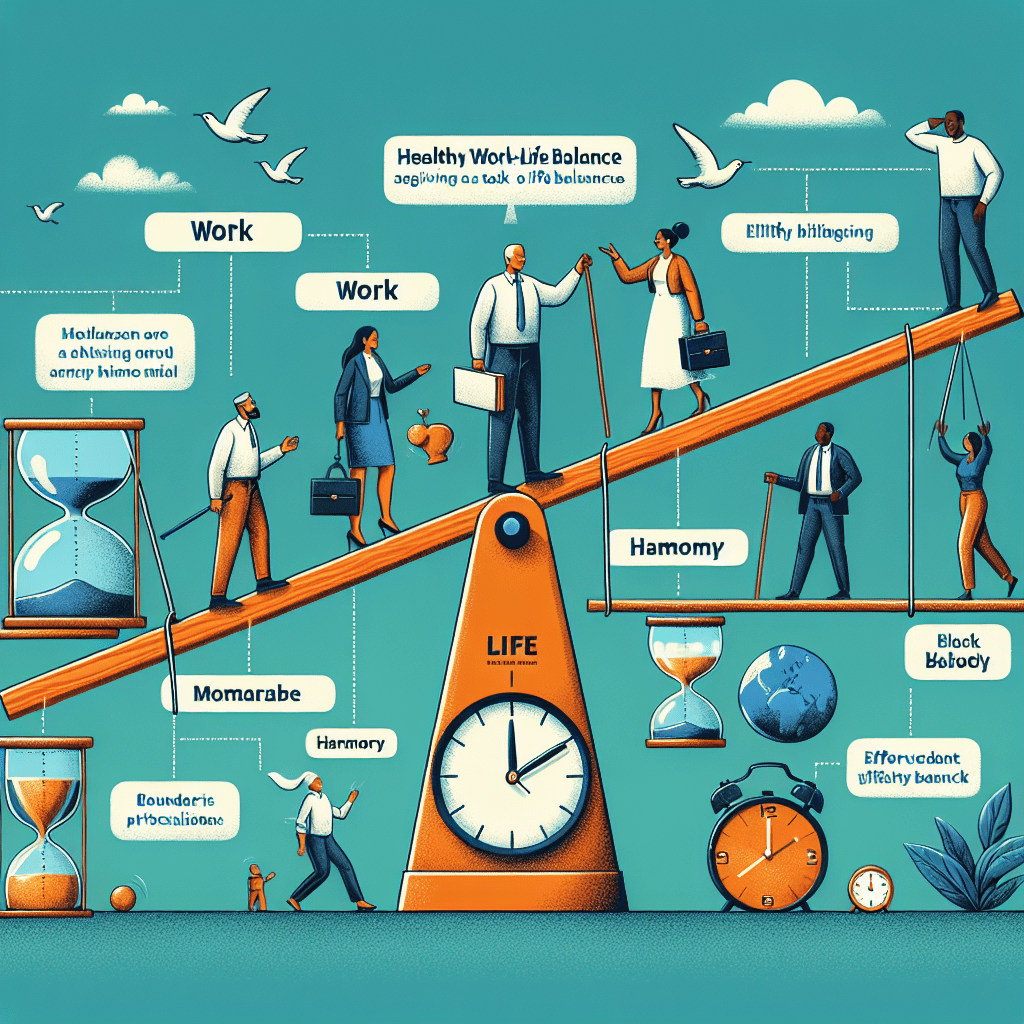How Can I Establish A Healthy Work-life Balance?Are you feeling overwhelmed and struggling to find a balance between your work and personal life? If so, you’re not alone. Many individuals nowadays are facing the challenge of juggling their professional responsibilities with their personal needs and desires. In this article, we’ll explore some practical tips and strategies to help you establish a healthy work-life balance that allows you to thrive in both areas of your life. So, if you’re ready to regain control and create a harmonious equilibrium, let’s dive in and discover how you can achieve that sought-after balance.
Understanding Work-Life Balance
Defining work-life balance
Work-life balance refers to the equilibrium between your professional responsibilities and personal life. It is about effectively managing and allocating your time and energy to both work and non-work activities. Striking a balance ensures that you have the time and space to focus on your career as well as your personal well-being.
Importance of work-life balance
Maintaining a healthy work-life balance is crucial for several reasons. Firstly, it can enhance your overall happiness and satisfaction. When you have time to pursue personal interests, spend quality time with loved ones, and take care of yourself, you are more likely to feel fulfilled and content. Secondly, it can reduce stress and burnout. Juggling excessive workloads without taking time for relaxation and self-care can lead to physical and mental exhaustion. Lastly, a good work-life balance can improve productivity and success in both your personal and professional life. When you are well-rested and have clear boundaries, you can focus better, make more thoughtful decisions, and ultimately perform at your best.
Factors affecting work-life balance
Several factors can impact your ability to maintain a healthy work-life balance. These include the demands of your job, the expectations of your employer, the level of support you receive, your personal commitments, and your individual priorities. It is essential to recognize and address these factors to ensure that you can achieve a sustainable balance between work and personal life.
Identifying Priorities and Values
Determining what matters most
To establish a healthy work-life balance, it is crucial to identify your priorities and values. Take the time to reflect on what is most important to you in both your personal and professional life. Consider your long-term goals, passions, and the activities that bring you joy. Understanding what matters most to you will help you make informed decisions and allocate your time accordingly.
Assessing personal and professional goals
Once you have identified your priorities, it is essential to assess your personal and professional goals. Determine what you want to achieve in both areas of your life and consider how they align with your values. Are there any conflicting goals that need to be addressed? By evaluating your goals, you can have a clear vision of what you want to accomplish and work towards a balanced approach that supports both personal and professional growth.
Aligning actions with priorities
Once you have a clear understanding of your priorities and goals, it is important to align your actions with them. Evaluate how you currently spend your time and identify any areas where adjustments can be made. Consider which activities can be delegated or eliminated to create more space for your priorities. By aligning your actions with your priorities, you can ensure that your time and energy are directed towards what truly matters to you.

Setting Boundaries
Separating work and personal life
Setting boundaries between work and personal life is crucial for maintaining a healthy balance. Establish clear guidelines regarding work hours and personal time. When you are at work, focus on your professional responsibilities and avoid engaging in personal activities. Conversely, when you are enjoying personal time, resist the temptation to bring work-related stress or tasks into that space.
Creating designated work areas
Creating designated work areas can help you separate work from personal life, especially if you work remotely. Set up a dedicated workspace that is separate from your living areas. This creates a physical boundary between work and personal life and allows you to mentally switch gears when moving between the two environments.
Establishing clear communication channels
Establishing clear communication channels is essential for maintaining work-life balance. Clearly communicate your availability and preferred modes of communication to your colleagues and employers. This can help manage expectations and prevent work-related interruptions during personal time. Utilize tools like email filters and setting boundaries around responding to non-urgent messages outside of work hours.
Managing Time Effectively
Creating a schedule
Creating a schedule is key to managing your time effectively and maintaining work-life balance. Allocate specific time blocks for different activities, including work, personal commitments, and downtime. Be realistic about how much time each task or commitment requires and ensure that you have adequate breaks and time for self-care.
Prioritizing tasks
Prioritizing tasks is crucial for managing your time efficiently. Identify the most important and urgent tasks and prioritize them accordingly. This can help you stay focused and ensure that you are using your time effectively. Consider using productivity techniques, such as the Eisenhower Matrix, to categorize tasks based on their importance and urgency.
Avoiding multitasking
Multitasking may seem like an efficient way to get more done, but it can actually hinder productivity and work-life balance. Instead, focus on one task at a time and give it your full attention. By avoiding multitasking, you can complete tasks more efficiently and reduce stress associated with trying to juggle multiple responsibilities simultaneously.

Practicing Self-Care
Taking breaks
Taking regular breaks is essential for maintaining work-life balance and preventing burnout. Incorporate short breaks throughout your workday to recharge and refocus. Use this time to engage in activities that relax and rejuvenate you, such as going for a walk, practicing deep breathing exercises, or chatting with a colleague.
Engaging in physical activity
Engaging in regular physical activity is not only beneficial for your physical health but also plays a vital role in work-life balance. Exercise releases endorphins, which can improve your mood and reduce stress. Find activities that you enjoy and incorporate them into your routine, whether it’s going for a run, attending a yoga class, or playing a sport.
Ensuring sufficient rest and sleep
Sufficient rest and sleep are crucial for overall well-being and work-life balance. Prioritize getting an appropriate amount of sleep each night to ensure that you are well-rested and able to perform at your best. Establish a bedtime routine, create a sleep-friendly environment, and avoid excessive caffeine or electronic devices close to bedtime.
Enhancing Productivity
Minimizing distractions
Minimizing distractions is essential for enhancing productivity and maintaining work-life balance. Identify common distractions in your work environment and take steps to minimize them. This could involve silencing notifications on your phone, using noise-canceling headphones, or working in a quiet and focused space.
Utilizing time management tools
Time management tools can significantly improve productivity and help maintain work-life balance. Explore different techniques and tools that align with your work style, such as to-do lists, calendar apps, or project management software. Experiment with different approaches to find what works best for you.
Batching similar tasks
Batching similar tasks can be an effective way to streamline your work and maximize productivity. Instead of jumping between different types of tasks throughout the day, try grouping similar activities together. For example, dedicate specific time blocks for responding to emails, making phone calls, or conducting research. Batching tasks can help you maintain focus and minimize the mental energy required to switch between different types of work.
Building a Support System
Seeking help
Building a support system is crucial for maintaining work-life balance. Reach out to colleagues, friends, or family members for help when needed. Delegating tasks or seeking assistance can lighten your workload and provide you with more time and energy for other aspects of your life.
Delegate tasks
Delegate tasks whenever possible to avoid becoming overwhelmed and improve work-life balance. Identify tasks that can be handled by others and collaborate with your team or colleagues to distribute responsibilities. Delegating tasks not only frees up your time but also promotes teamwork and helps others develop new skills.
Networking and collaborating
Networking and collaborating with others can also contribute to work-life balance. Engage in professional communities and build connections with individuals who share similar interests or goals. Collaboration can lead to shared experiences, ideas, and resources, making it easier to navigate both your personal and professional life.
Learning to Say No
Setting boundaries
Learning to say no is essential for establishing and maintaining work-life balance. Set boundaries and be selective about what commitments you take on. Practice prioritizing your own needs and goals, and be willing to decline opportunities or requests that do not align with your priorities.
Evaluating commitments
Regularly evaluate your commitments to determine if they are still aligned with your priorities and goals. Take the time to assess whether certain activities or obligations are adding value and contributing to your overall well-being. Be willing to let go of commitments that no longer serve you.
Saying no without guilt
Saying no can be challenging, especially if you are a people-pleaser. However, it is important to remember that saying no is not selfish but rather a way to protect your work-life balance and well-being. Practice saying no without feeling guilty, and communicate your boundaries and reasons clearly, while respecting the needs and perspectives of others.
Promoting Flexibility
Negotiating flexible work arrangements
Promoting flexibility in your work arrangements can significantly contribute to work-life balance. If possible, explore options for flexible working hours, remote work, or compressed workweeks. Discuss these possibilities with your employer, highlighting the potential benefits for both you and the organization.
Utilizing remote work options
Remote work options can provide greater flexibility and work-life balance. If your job allows for remote work, consider taking advantage of this opportunity. Working from home can eliminate commuting time and provide a more comfortable and flexible environment, allowing you to better integrate your personal and professional activities.
Employing technology for virtual collaboration
Advancements in technology have made virtual collaboration more accessible and efficient. Utilize tools such as video conferencing, project management platforms, and instant messaging to connect and collaborate with colleagues, even if you are not physically together. Virtual collaboration allows for greater flexibility and can help integrate work and personal life more seamlessly.
Seeking Work-Life Integration
Identifying overlapping areas
Work-life integration involves finding areas where your personal and professional life can overlap and complement each other. Identify activities or projects that align with both your personal interests and professional skills. By pursuing opportunities that combine your passions and work, you can create a more harmonious and fulfilling lifestyle.
Combining work and personal activities
Look for opportunities to combine work and personal activities to achieve a better work-life balance. For example, consider attending professional development events or seminars that align with your personal interests. By finding ways to integrate work and personal activities, you can maximize your time and enjoy a more integrated approach to life.
Adapting a holistic approach
Adapting a holistic approach involves recognizing that work-life balance is not just about dividing your time between different areas of life but rather integrating and harmonizing them. Embrace the idea that personal and professional aspects of your life are interconnected and strive for overall well-being. Take care of your physical, mental, and emotional health to ensure that you are thriving in all aspects of your life.
Conclusion How Can I Establish A Healthy Work-life Balance?
In conclusion, achieving a healthy work-life balance is essential for overall well-being and success. By understanding the concept of work-life balance, identifying your priorities, setting boundaries, managing time effectively, practicing self-care, enhancing productivity, building a support system, learning to say no, promoting flexibility, seeking work-life integration, and adopting a holistic approach, you can create a fulfilling and sustainable balance between your personal and professional life. Remember, it is an ongoing process that requires self-awareness, continuous evaluation, and proactive decision-making to nurture and maintain a harmonious and rewarding lifestyle.
